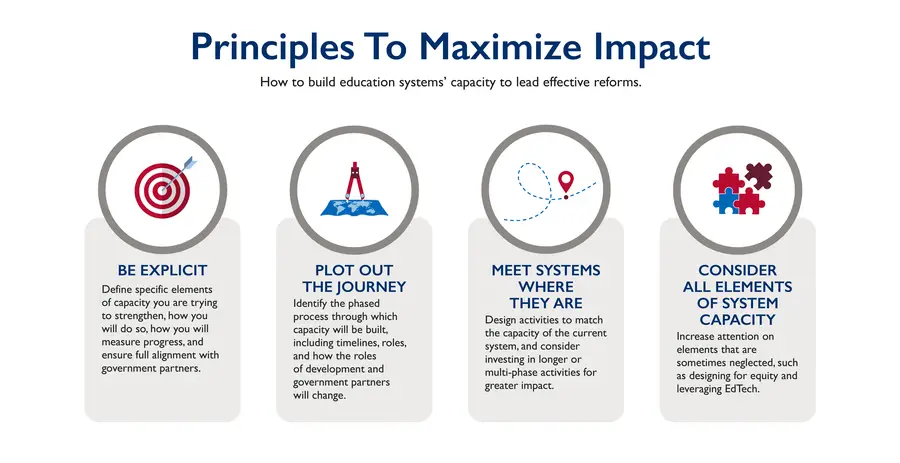This blog was written by Richard Eyre and Raahema Siddiqui of Delivery Associates, an RTI subcontractor on the USAID-funded All Children Reading-Asia (ACR-Asia) task order under which the work described in this article was conducted.
High-quality education can be transformational, both for individuals and whole societies. But during the last few years, there has been an increasing awareness in the education development sector that promoting specific education interventions—or even helping countries to implement those interventions with fidelity— is often not sufficient to yield lasting, transformative results.
Why? Because unless development activities also strengthen the implementation capacity of the system within which they are working, their impact is likely to be a limited, one-time solution to a discrete problem.
For instance, an activity might introduce a new approach to reading instruction, but it does not automatically mean that local and national leaders will be able to:
- Sustain the approach beyond the lifetime of the support provided by the activity.
- Problem-solve if the initial impact of the approach starts to fade.
- Scale the approach to more schools and districts.
- Implement an equivalent strategy for a different subject or phase of education.
The skills and behaviors required to achieve those things have to be intentionally built through a process of “systems strengthening.”
The recently published USAID Systems Strengthening Review documented how USAID-funded activities have helped to strengthen implementation capacity in education systems across Asia. One particularly insightful example of systems strengthening was observed in Cambodia, which the Review explored as part of a Deep-Dive Case Study.
A Sequence of Education Systems Strengthening
Starting in 2017, USAID launched three successive Activities with the aim of improving early grade reading skills of children in Cambodia, each with its own key objectives:
- All Children Reading (ACR): Uniting relevant implementing partners and development partners together to pilot a national program for early grade reading
- All Children Learning (ACL): Building on the work of ACR to “solidify it as a national program”
- Inclusive Primary Education Activity (IPEA): Supporting the government to scale the program across the country.
These Activities strengthened the ability of Cambodia’s education system to implement effective reforms in a number of specific respects.
Setting education goals and reform strategy in Cambodia
- Defining clear goals. The sequence of Activities in Cambodia helped the system evolve its approach to education reform, moving beyond counting inputs and outputs towards an increasing focus on student reading outcomes. As of now, the Education Strategic Plan 2019-2023 of the Ministry of Education, Youth and Sport (MoEYS) states that it aspires to improve learning outcomes for students and implement the model of early grade reform across the country.
- Determining the reform strategy. The Activities supported the Ministry to harmonize the approach to early grade reading in Cambodia by bringing key donors and NGO players to the table and aligning them behind a national strategy to scale the reforms.
- Visualizing the delivery chain. By better understanding the chain of actors involved in implementation and addressing capacity challenges along the delivery chain, key MoEYS staff are now better positioned to implement reform. For instance, clarity gained from analyzing the delivery chain enabled MoEYS to secure a key change in education financing that directed funds to be earmarked for teacher mentoring support by districts.
When the program started out, there were a lot of fragmented approaches being used for early grade reading. We consolidated best practices and introduced a harmonized reading package in consultation with the Ministry. -Anonymous study participant response.
Systems and behaviors to drive delivery of education
- Using data effectively. The Activities have equipped Cambodia’s education system to establish new sources of assessment data and bolster monitoring efforts. This includes integrating the use of assessments to test different models and training staff to analyze national assessment data.
- Monitoring performance and solving problems. Data-informed conversations with system leaders have provided a high-level platform for identifying and addressing challenges. For example, data showing relatively weak performance of Grade 3 students’ learning of foundational consonants during a Steering Committee meeting helped leaders to identify (and rectify) a missing component in the teacher training curriculum.
- Harnessing the power of relationships. The system now uses a harmonized approach to reach its goals, with NGOs and other key stakeholders working towards the rollout of the national reading package under a strategy led by MoEYS.
Before 2017, there were many development and NGO partners in early grade reading in Cambodia. Since the harmonization of the package, all of them are on the same page and use it in their areas. - Anonymous study participant response.
Create an improvement culture
- Reviewing capacity to deliver. Periodic reviews have informed design and implementation of all three Activities, at times even helping key MoEYS departments to identify their own capacity gaps.
- Building system capacity all the time. The Activities have been working closely with MoEYS officials from the beginning to enhance their capacity and gradually transition more responsibilities to them as the program progresses. The aim is to eventually transition ownership of reforms to government counterparts.
- Leveraging educational technology. As a response to the global pandemic, the Activities supported the system to introduce a blended approach for teacher training, create free digital libraries for learning materials, and broadcast video lessons on TV. Additionally, MoEYS received support to make strategic decisions on how to integrate EdTech in a way that matched the context and capabilities of the system.
- Promoting equity and inclusion. Through the Activities, the system has started incorporating equity and inclusion into its reform efforts, including targeting areas with low learning outcomes and high dropout rates, and implementing interventions with equity considerations. An example of designing for equity was when IPEA focused on tailoring instruction to the needs of children with visual or hearing disabilities by training teachers to deliver inclusive lessons and assessments.
The project provided evidence for inclusive education in Cambodia and helped teachers see children can learn despite having a disability. It has really been catalytic in moving those conversations forward. - Anonymous study participant response.
What Conditions Contributed to the Activities’ Impact on Education Systems Strengthening?
First, the project was set up as three successive Activities that reinforced each other, leading to greater systems strengthening impact. This sequencing pattern (as opposed to an assortment of one-time investments) allowed the Activities to work closely with government counterparts over a span of several years to build their capacity, pilot, test and embed new approaches, and engage in long-term financial planning. The Activities also included an explicit focus on systems strengthening in their objectives from the beginning, placing an emphasis on institutional capacity building. By cultivating close relationships to co-lead the work, the Activities found it easier to secure government buy-in. Finally, the Activities recognized the need to align donor activities early on, prompting them to adopt a harmonized approach in coordinating between different NGOs and development partners. Doing so, enabled key stakeholders and other implementing partners to act with a “laser focus on learning outcomes.”
USAID’s role wasn’t about implementing a project successfully but [it was] more about influencing the sector in a way that it moves closer to a coherent approach to institutional capacity. - Anonymous study participant response.
What are the Lessons for Designing Future Activities?
Drawing on the experience of Cambodia, and similar Activities in other countries, the USAID Systems Strengthening Review identified the following key principles that can guide future Activities to achieve significant and sustainable impact on education systems’ implementation capacity:




